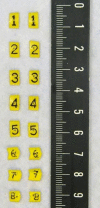Relocation of inadequate resection margins in the wound bed during oral cavity oncological surgery: A feasibility study
- PMID: 30706624
- PMCID: PMC6618026
- DOI: 10.1002/hed.25690
Relocation of inadequate resection margins in the wound bed during oral cavity oncological surgery: A feasibility study
Abstract
Background: Specimen-driven intraoperative assessment of the resection margins provides immediate feedback if an additional excision is needed. However, relocation of an inadequate margin in the wound bed has shown to be difficult. The objective of this study is to assess a reliable method for accurate relocation of inadequate tumor resection margins in the wound bed after intraoperative assessment of the specimen.
Methods: During oral cavity cancer surgery, the surgeon placed numbered tags on both sides of the resection line in a pair-wise manner. After resection, one tag of each pair remained on the specimen and the other tag in the wound bed. Upon detection of an inadequate margin in the specimen, the tags were used to relocate this margin in the wound bed.
Results: The method was applied during 80 resections for oral cavity cancer. In 31 resections an inadequate margin was detected, and based on the paired tagging an accurate additional resection was achieved.
Conclusion: Paired tagging facilitates a reliable relocation of inadequate margins, enabling an accurate additional resection during the initial surgery.
Keywords: intraoperative assessment; oral cavity; relocation; resection margin; specimen driven.
© 2019 The Authors. Head & Neck published by Wiley Periodicals, Inc.
Conflict of interest statement
None declared.
Figures




References
-
- Helliwell T, Woolgar J. Standards and Datasets for Reporting Cancers. Dataset for Histopathology Reporting of Mucosal Malignancies of the Oral Cavity. London: The Royal College of Pathologists; 2013.
-
- Smits RW, Koljenovic S, Hardillo JA, et al. Resection margins in oral cancer surgery: room for improvement. Head Neck. 2016;38(Suppl 1):E2197‐E2203. - PubMed
-
- Dillon JK, Brown CB, McDonald TM, et al. How does the close surgical margin impact recurrence and survival when treating oral squamous cell carcinoma? J Oral Maxillofac Surg. 2015;73(6):1182‐1188. - PubMed
-
- Varvares MA, Poti S, Kenyon B, Christopher K, Walker RJ. Surgical margins and primary site resection in achieving local control in oral cancer resections. Laryngoscope. 2015;125(10):2298‐2307. - PubMed
-
- Slootweg PJ, Hordijk GJ, Schade Y, van Es RJ, Koole R. Treatment failure and margin status in head and neck cancer. A critical view on the potential value of molecular pathology. Oral Oncol. 2002;38(5):500‐503. - PubMed
MeSH terms
LinkOut - more resources
Full Text Sources
Other Literature Sources
Medical

